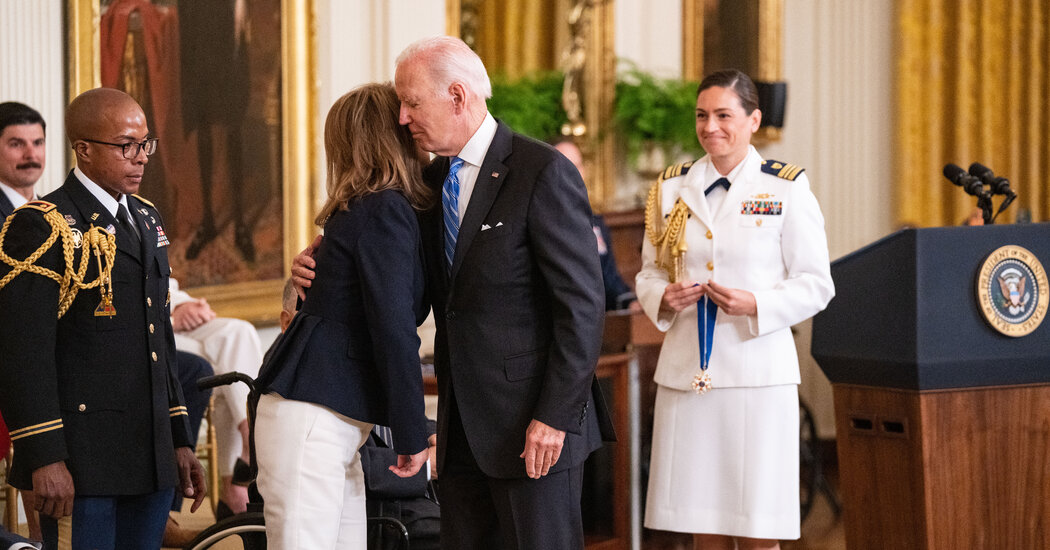
WASHINGTON — One after another, President Biden hugged and kissed them.
At a packed ceremony in the East Room of the White House on July 7, Mr. Biden bestowed the Presidential Medal of Freedom, the nation’s highest civilian honor, on 16 Americans, some in their 80s or 90s. After reaching around to hang the medal on their necks, the president embraced most of them, shook hands with a few and gave three a smooch on the cheek.
It is highly unlikely that Mr. Biden — who tested positive for Covid-19 on Thursday — became infected with the coronavirus during that event. But the fact that the celebration happened at all underscores how much the White House has dropped most of the extraordinary measures it once employed to protect the commander in chief from a disease that has killed more than one million Americans.
In the early days, Mr. Biden was a president in a bubble, governing the country mostly by Zoom inside the Oval Office. He rarely traveled. He held few in-person meetings. And most of the ceremonial trappings of the office — like the medal ceremony — were canceled or postponed, victims of the lockdowns that were deemed necessary to stop the spread.
But like many other Americans, Mr. Biden has loosened up in recent months. Protected by multiple doses of the vaccine, the president and his aides have changed their risk assessments and have begun to live with the coronavirus.
“Whatever your thing is — whether it’s being the president of the United States, going to school, going to work, doing the things you enjoy, being with who we love — it can’t be put off forever,” said Andy Slavitt, who advised the White House on its Covid-19 response early in the Biden administration.
Mr. Slavitt said Covid-19 has become a disease that “comes around as frequently as a common cold but with much more severe consequences. It’s a much more uncomfortable middle state for people to adjust to.”
Inside the West Wing, there was never much doubt that Mr. Biden would eventually contract the disease. By this week, many of the people around him already had: Vice President Kamala Harris; Jen O’Malley Dillon, his deputy chief of staff; Karine Jean-Pierre, his press secretary; several cabinet members, including the attorney general; Doug Emhoff, the second gentleman; and Jen Psaki, his former press secretary — twice.
On Friday, Mr. Biden’s physician said his symptoms had improved. The president had a temperature of 99.4 degrees late Thursday evening, according to Dr. Kevin O’Connor, in a letter released on Friday. He wrote that Mr. Biden was still experiencing a runny nose and fatigue, and that he had an “occasional nonproductive, now ‘loose’ cough.”
“His voice is deeper this morning,” Dr. O’Connor wrote. “His pulse, blood pressure, respiratory rate, and oxygen saturation remain entirely normal, on room air.”
The deeper tone in Mr. Biden’s voice was noticeable on Friday, when he participated by video in a briefing on declining gas prices. Mr. Biden cleared his throat multiple times during his remarks and could be heard coughing.
Dr. Ashish K. Jha, the coordinator for the administration’s Covid-19 response, said that Mr. Biden’s temperature of 99.4 on Thursday was not considered a low-grade fever by the White House and that it fell “within the normal range.” He added, however, that he was unaware of Mr. Biden’s temperature recorded Friday morning. The White House referred to guidance from the Centers for Disease Control and Prevention that states a person is considered to have a fever “when he or she has a measured temperature of 100.4 degrees” or feels warm to touch.
But in his letter, Dr. O’Connor indicated that he did not feel that the president’s temperature of 99.4 was normal until after it responded to Mr. Biden taking Tylenol. Dr. Jha said later on Friday that it was routine for doctors to report the highest temperature of their patients, even if it was not a fever.
“He did mount a temperature yesterday evening to 99.4°F, which responded favorably to acetaminophen (Tylenol),” Dr. O’Connor wrote. “His temperature has remained normal since then.”
Dr. Jha said Dr. O’Connor did not prescribe the Tylenol for the temperature, but rather for Mr. Biden’s “discomfort.” Dr. Jha declined to say what discomfort the president was experiencing. Officials have said he does not have a sore throat or a headache, and have not indicated he has other aches and pains.
The White House went to great lengths this week to show that Mr. Biden’s work life had not been dramatically affected by his diagnosis.
The White House Twitter account posted three photos of the president working at a desk in the White House residence. In one, he can be seen talking on the phone. In another, he is signing a law designed to give people more access to baby formula.
Mr. Biden was elected in no small measure because he persuaded voters to trust that he could bring the pandemic under control and reopen the country.
In the last 18 months, Mr. Biden has achieved much of that goal. Because of the widespread availability of vaccines and treatments, most communities have reopened stores, bars, sporting venues and schools. There are few mask mandates still in place.
Mr. Biden now travels abroad (he shook hands with numerous world leaders during a trip last week to Israel and Saudi Arabia). He holds political events around the country, flying on Air Force One and riding in the motorcade. And in-person events at the White House are a weekly occurrence again.
But the pandemic is not over.
According to the C.D.C., most of the country is now classified as areas with high community transmission. The latest Omicron subvariant to become dominant, BA.5, is vastly more contagious than the original coronavirus, though doctors say the vaccines remain effective at preventing hospitalization and death.
So Mr. Biden has to walk a careful line, demonstrating that he is just like every other American eager to be done with Covid-19, even as he keeps his eye on the possibility that the pandemic could come roaring back.
The White House tried to do that on Friday by using the president’s diagnosis as a case study for why Americans should get vaccinated and boosted.
“We’re in a much, much better place than where we were 18 months ago, when the president took office,” Dr. Jha said, adding that the current level of about 400 Covid-19 deaths per day was “unacceptable.” He also added a grim warning.
“This virus,” he said, “is going to be with us forever.”

